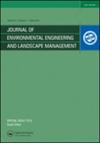ARBUSCULAR MYCORRHIZAL SYMBIOSIS OF VIOLA BAOSHANENSIS AT BAOSHAN PB/ZN MINE IN CHINA
IF 1
4区 环境科学与生态学
Q4 ENVIRONMENTAL SCIENCES
Journal of Environmental Engineering and Landscape Management
Pub Date : 2024-03-20
DOI:10.3846/jeelm.2024.20971
引用次数: 0
Abstract
Despite great potential for arbuscular mycorrhizal fungi (AMF) in restoration of heavy metals (HMs) polluted lands, limited information is available about the arbuscular mycorrhizal (AM) symbiosis of naturally-occurring hyperaccumulators. A preliminary survey was conducted to investigate the AM symbiosis of Viola baoshanensis, a Cadmium (Cd) hyperaccumulator, growing at an abandoned mine. Shoot/root ratios of 1.78 for Cd, and 2.57 for zinc (Zn) indicate that these two metals were preferentially transported from roots to shoots, whereas the ratio of 0.32 for lead (Pb) shows that most Pb was stored in roots. High level of colonization was found in the roots of V. baoshanensis with relative mycorrhizal root length of 69.1%, relative arbuscular richness of 46.9% and relative vesicular richness of 1.7%. Fifteen AMF species were identified from the root zone soil of V. baoshanensis. The dominant AMF genus was Glomus, and the most abundant species were Glomus ambisporum and Claroideglomus etunicatum.中国宝山铅锌矿紫云英的丛枝菌根共生关系
尽管丛枝菌根真菌(AMF)在重金属(HMs)污染土地的恢复中具有巨大潜力,但有关天然存在的高积累植物的丛枝菌根共生的信息却很有限。研究人员对生长在废弃矿山的高镉积累植物 Viola baoshanensis 的 AM 共生情况进行了初步调查。镉(Cd)和锌(Zn)的芽/根比率分别为 1.78 和 2.57,表明这两种金属优先从根转移到芽,而铅(Pb)的比率为 0.32,表明大部分 Pb 储存在根中。在宝山鹅掌楸的根中发现了高水平的定殖,相对菌根长度为 69.1%,相对树胶富集度为 46.9%,相对泡状富集度为 1.7%。从宝山鹅掌楸根区土壤中鉴定出 15 种 AMF。主要的 AMF 属是 Glomus,最丰富的物种是 Glomus ambisporum 和 Claroideglomus etunicatum。
本文章由计算机程序翻译,如有差异,请以英文原文为准。
求助全文
约1分钟内获得全文
求助全文
来源期刊
CiteScore
1.90
自引率
7.70%
发文量
41
审稿时长
>12 weeks
期刊介绍:
The Journal of Environmental Engineering and Landscape Management publishes original research about the environment with emphasis on sustainability.

 求助内容:
求助内容: 应助结果提醒方式:
应助结果提醒方式:


